WORLD CLASS COACHING
Tactical Series Pep Guardiola
By Luca Bertolini
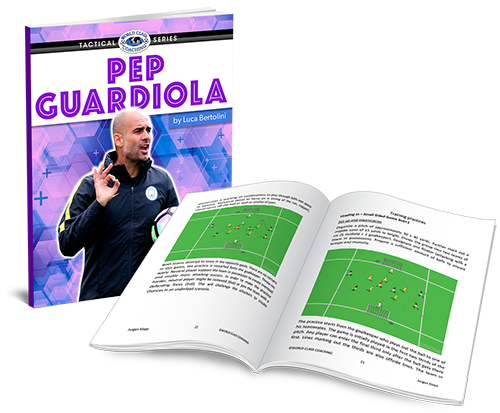
Table of Contents
PART TWO
Guardiola's New Way of Attacking and Possession on the Flanks
The Development of Positional Play Games
The Importance of Half Spaces
A new concept of width in Guardiola's possession and attacking phases
We see great differences regarding exploitation of the wide spaces between Guardiola's FC Barcelona seasons and his two years at City.
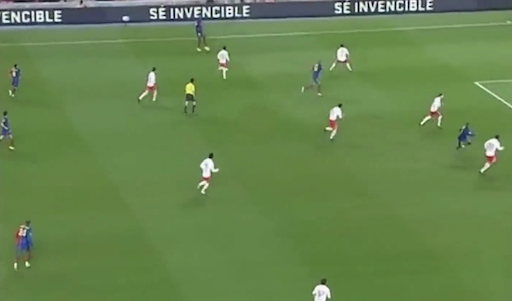
Abidal looked for a deep teammate on the left side (Henry is running deep in behind here)...

...or to make overlap runs to send a cross toward the opposition goal area (he is making an overlap run past to Henry in the move up here).
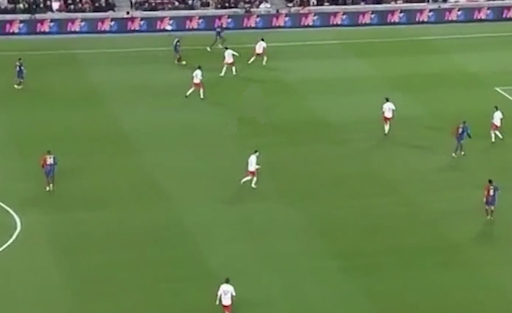
On the right side, Daniel Alves was used to play inside the field from the flank.
This position must not be confused as an inverted fullback role; Alves was used to dribble inside to overload the center space of the opposition in the final third, inviting them to put pressure and opening spaces at the back.
The Guardiola's inverted fullbacks usually have an important role during the building up phases of play as well as during transition to defend phases.
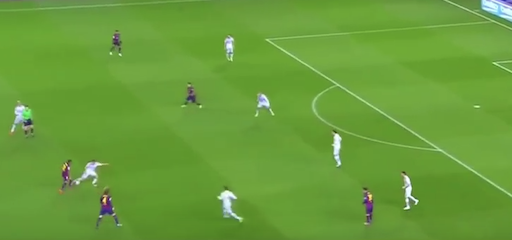
Guardiola exploited the idea of inverted fullbacks during his seasons as Bayern Munich manager with Lahm and Alaba. His improved this usage during these last two seasons at Manchester City with Clichy and Sagna first and then with Delph, Otamendi and Danilo, more than with Walker.
Another aim was to make a run to receive a pass behind the opposition defense line, but always toward the goal (in this move Alves is receiving the ball from Xavi after a diagonal run toward the goal)...
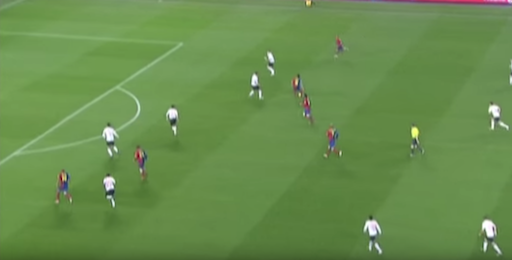
...or to finish also.
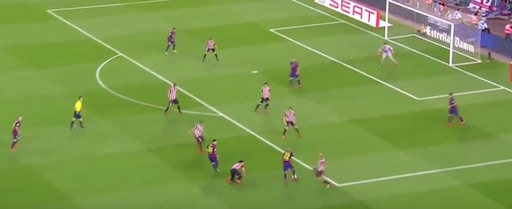
Fc Barcelona’s pattern of play required the fullbacks to exploit the wide spaces and to be decisive together with the midfielders, Xavi and Iniesta and with Messi. Barcelona considered the width as the space between the widest opponents in the final third or the goal area width. The direct attacks to the goal were the only solutions to finish.
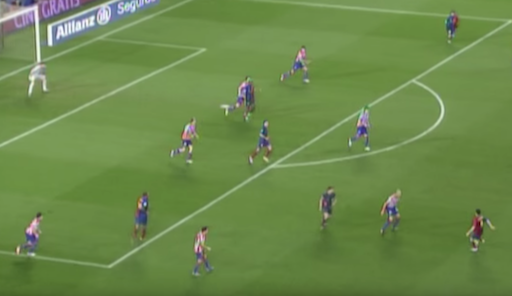
Xavi had the ball in this move and the widest players were Henry on the left and Messi on the right, near the upper corners of the penalty area.
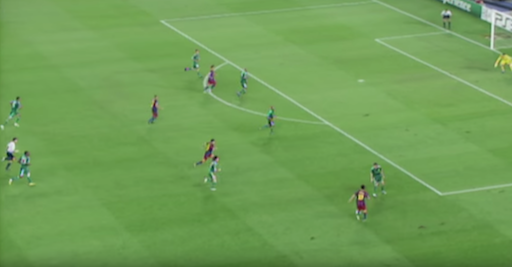
Messi dribbled the ball and all the others were attacking the goal to receive behind the defense line.
Manchester City’s style of play requires wide wingers on the sidelines, to play 1 v 1 duels (the opposition penalty area is clearly much more overloaded of players than during the Barcelona seasons, as a 4 v 4 is played inside it)...
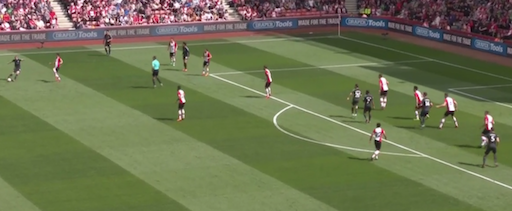
...or to create small duels if the opposition is able to cover ball zone (a 3 v 3 can be easily recognizable) to play in behind the defense line through the inside runs without the ball along the half spaces.
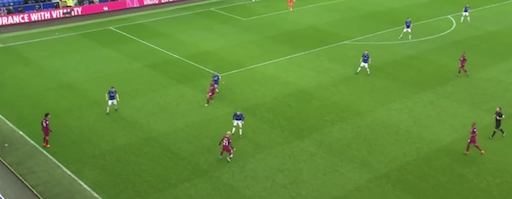
After quick and short passing patterns and the attacking phase through the center that Guardiola proposed during the seasons as Barcelona manager, he changed his approach at Bayern, working on the best abilities and skills of his players; the focus was now on the wingers (Robben, Ribery, Müller and Douglas Costa).
Manchester City may be considered as a mix with 1v1 wide situations on the flanks that are a recurrent solution during the attacking phases, and the center spaces and half spaces that are useful to build up and to finish.
Horizontal and diagonal movements of City’s middle players, when the wingers are on the ball, De Bruyne, Silva, Gundogan, Bernardo Silva, invite the opposition center defenders out of position, opening spaces behind them.
Again, to move the opposition defense line and invite them to overload one side to switch the play...
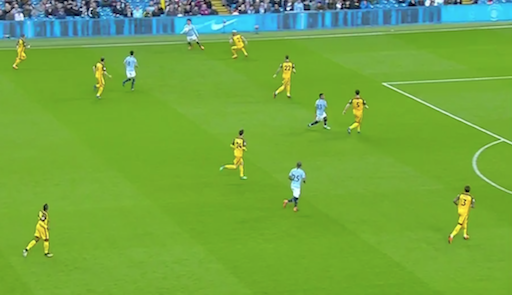
...to open center spaces and to combine along the weak zone of the opposition after the change of a side...
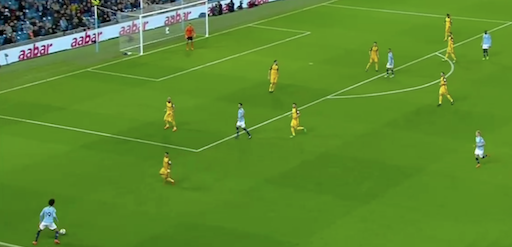
...and to have the chance to play 1 v 1 duels.
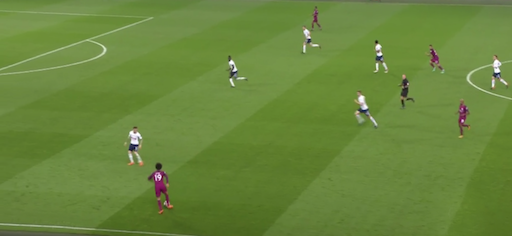
If the support and center players are not immediately close to the wingers, and if the defenders can't be beaten, the rhythm of the attacking phase is slowed down, waiting for them and their cutting movements in front of the penalty area.
The development of the positional play game
Pep Guardiola’s fundamental football philosophy is, obviously, the "juego de posición,” the positional play game; concerned with the spaces and how to exploit them when in possession, and how to cover them while in non-possession phases.
As Barcelona manager, Guardiola took a few months before his team was showing clear signs of these positional play games, thanks to the history of the club, to its organization and training methods of the youth academy.
As Bayern coach, he needed a full season, but it shouldn't be forgotten that the whole organization of the team changed and the positional play games were not only a tool to attack and to finish, but they were a tactical solution to adapt his football philosophy to the players; and last but not the least, to play wide rather than in the center spaces.
Manchester City players seem to have helped Guardiola to develop his positional play games, making them easier and faster, looking at the speed of play of the building up and of the finishing phases; City is much faster and more direct than Barcelona and Bayern. Moreover, long balls have appeared.
If Barcelona played and finished thanks to pattern of play in behind the opposition defense line, Bayern played, and much more Man City plays, wide and through the weak sides of the opposition. What Barcelona, Bayern and Manchester City have in common are the right distances between each player in relation to the systems and the patterns of play that were and are shaped on the pitch.
The opposition is usually forced to adapt its defensive shape to mark the positional play, which leaves the lines stretched, or to choose to ignore the positional play, leaving an underloaded side of the field free for exploitation, marking the most dangerous players; but this tactic leaves the team able to switch the side quickly and the attacking players to position themselves between the lines.
Even if Guardiola’s Juego de Posición does not often require playing vertically quickly, and if the priority is to play forward into advanced areas in preparation of both attack and defense transitions, the rhythm and the timing seem to have been increased during these two seasons at Manchester City.
To control the ball is the key and the controlled possession, finding the right positions on the field, is an important objective to move the opposition defense; Manchester City players move into these positions in relation to the ball quicker then ever, both from the offensive and the defensive points of view.
If the opposition defense structure is very strong and it's difficult to be penetrated, then longer passes are used switching the side; and here again, the positional play game has developed.
The positional play games of Pep Guardiola have been changed, helping City to dominate the possession without losing the peculiar speed of english style of play; width penetration and creation of the final balls are fast then ever.
The "Half Spaces"
A ‘half space’ is a channel between the fullback and center half on either side of the area; many of Manchester City’s goals come from here. When Man City builds up from the back, the fullbacks come into the center midfield to overload it, the wingers stay placed out wide and force the opposition fullbacks to be placed back and wide there.
The half space concept has been created and developed by Guardiola through the seasons; it was not the same with Barcelona and not the same, even if closer, with Bayern Munich.
With Fc Barcelona, the first objective of the possession phase was to get the ball to the most creative players free inside opposition spaces and the wide players didn't use the full width of the pitch, being often placed between the opposition fullback and center back on either sides; the opposition players were invited away from the central zone, creating a positional and quality advantage if it couldn't be numerical advantage.
The wide players then ran in behind, when the midfielders were in possession inside the upper area of the middle third, while Messi was often dropping back to invite the defenders out.
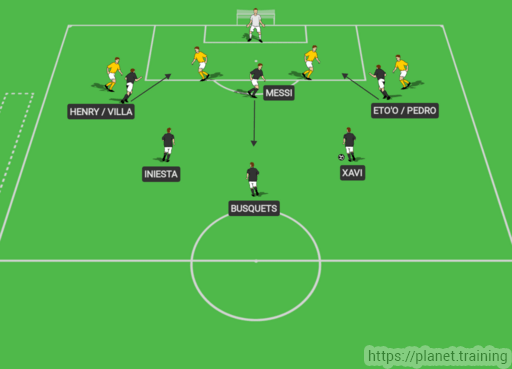
At Bayern Munich Guardiola asked the training pitches to be cut to highlight the half spaces and he began to use the inverted fullbacks when the team was attacking, creating center numerical advantage, overloading this area and leaving the wingers free out wide to play 1 v 1 against the opposition fullbacks.
This is a division of the spaces for the positional play games on the field:
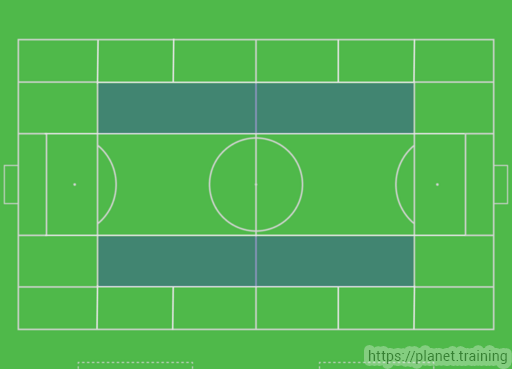
4 lines split the pitch vertically into 5 zones of nearly same measures. The flanks lines are the extension of the sidelines of the penalty area along all the pitch till the opposite one and the center space is divided into three parts along the field as well. The outer corridors are the half spaces.
These spaces are the tools to move the opposition defense set-up and to disorganize it.
The winger and the fullback don't have to be placed along the same corridor but they must play along different spaces, depending on the position of the center defender in relation with them.
The center defender should be free in the middle, the fullback should be placed in the half space and the winger must be out wide to receive the ball, as well as the center forward.
The opposition winger is supposed to follow the fullbacks in the center; if he doesn't, there is a free player in the middle and if the opposition center midfielder tries to cover the space around him, an advanced midfielder is then free to receive.
The advanced midfielders and the opposite fullback must exploit the middle space now created.
The main principle of play in these situations is to ensure the numerical advantage in the middle third.
If the fullback builds up wide and dribbles forwards, the center forward follows him and the winger must now play in the half spaces and even through the center spaces, attacking the depth.
The center forward is free to move if the opposition center back comes out from defense line; in addiction, one advanced midfielder often run deep to support the attacking move (Thiago Alcantara more than all the others during those seasons).
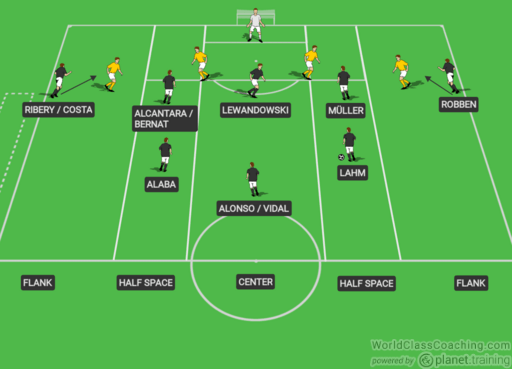
The City's inverted fullbacks are different from Lahm and Alaba, as they are not play makers but they link the play out phase from the defenders to the wingers; the lower play maker is usually the balance player and the advanced play makers are always David Silva, Gundogan, Bernardo Silva or even De Bruyne.
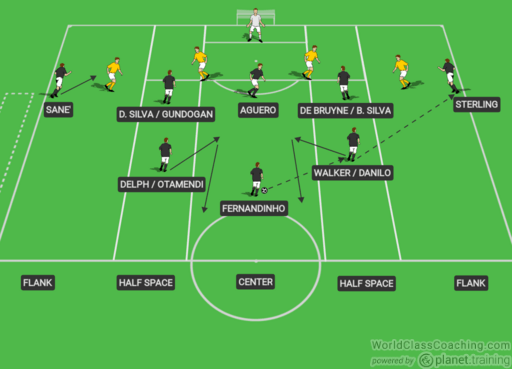
They are extremely athletic to get back into position if the ball is lost, as opposition long ball are the most recurrent tactic to counter attack; they must get back within two or three seconds. During the first season as City manager, the opposition attacks on the counter were hard issues to fix.
“When you have Xavi, Iniesta, (Sergio) Busquets, Messi, (Cesc) Fabregas, it is normal you play in that position, in the middle. When you have players here like Sane, (Raheem) Sterling and (Kevin) De Bruyne, we attack more the spaces. In football there are fundamentals, but you adapt them to the players you have.”


